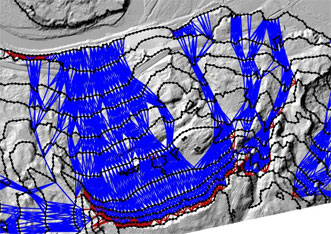For communities that have been devastated by wildfire, swift access to clean water is a critical first step
to recovery.
After the 2018 Camp Fire devastated Paradise, California, Erica Fischer, assistant professor of structural engineering, traveled to the burn area to investigate problems with water quality. She learned that contamination occurred at different points within the infrastructure as pipeline materials reached critical temperatures.
“I wanted to investigate that further,” Fischer said. “Since everything is dependent upon water, how do we identify sources of contamination more quickly when this happens again?”
To meet that challenge, Fischer and a team of researchers will develop and deploy an affordable and easy-to-use sensor network for pipelines that can be deployed to regions of high wildfire risk. The sensors will indicate whether critical temperature thresholds have been surpassed during the fire and where pipelines need to be repaired. The project is funded by a $1.5 million grant from the Alfred P. Sloan Foundation.
“The goal is not to tell communities what kinds of pipelines to use, but rather to arm them with information so they can make informed decisions themselves,” Fischer said.
In the seven-phase project, the team will conduct tests to determine critical temperatures for various buried water-infrastructure materials, develop the sensor, and conduct case studies on municipalities that employ outreach tools, which synthesize satellite imagery, sensor data, and social media activity. Fischer and colleagues will also organize workshops to receive feedback from key stakeholders within high-risk communities on the project.
Project team members include Oregon State faculty members Lisa Ellsworth (College of Agricultural Sciences) and Jenna H. Tilt (College of Earth, Ocean and Atmospheric Sciences); Lauren Linderman, assistant professor of structural engineering at the University of Minnesota; and Brad Wham, assistant research professor and managing director of the Center for Infrastructure, Energy, and Space Testing at the University of Colorado Boulder.
“Ultimately, this research will allow communities to make decisions equitably, with science-backed information, and go to where the sources of contamination are,” Fischer said. “There is information that different socioeconomic groups will report damage after a disaster at different speeds and rates. A lot of the time, we go after the squeaky wheel, but maybe that’s just where more people are complaining.”



